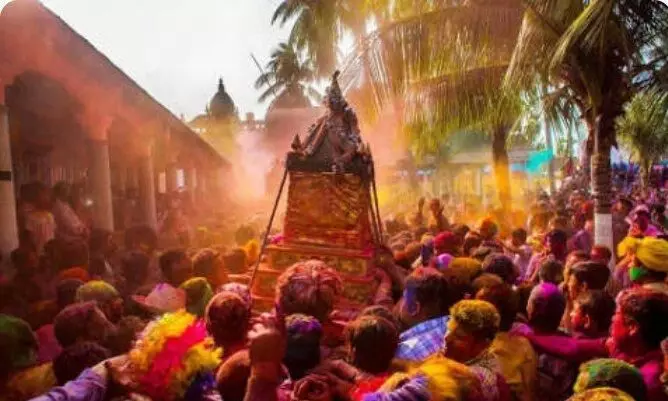
Source: Twitter
Guwahati, March 18: One of the most celebrated and recognised festivals of India is Holi. The occasion is marked by frolic and friendly fights with colours, leaving behind the agonies and grudges. India celebrates Holi in a varied way but the core belief is to celebrate the victory of good over evil.
In some parts of the country, a human pyramid is formed to break the pot of buttermilk hung high up resembling Krishna's habit of stealing butter and milk stored in terracotta pots while in other parts women are seen chasing men and playfully beating them up with lathis (sticks) as a part of the tradition.
Here in Assam, Holi is observed in a unique way commencing the arrival of spring whilst marking the eternal and divine love of Radha Krishna. Popularly known as Doul Utsav, and celebrated enthusiastically in Barpeta Satra (Monastery), the statue of Krishna, also called 'Kaliya Gosain' (the dark-skinned lord) by the locals, is carried around ritualistically in a procession as devotees pay their obeisance.
Photo: Ankur Das
Around 95 kms away from Guwahati city, Barpeta has decked up to celebrate the enormously popular and colourful festival of Holi or Doul Utsav, locally known as Deul. The celebration represents the unique culture of Barpeta Satra, which is considered as one of the most revered Vaishnavite centres of Assam.
The Doul Utsav is celebrated in Barpeta Satra is unique to the region and is based on the legend of Lord Krishna's visit to his consort Ghunusa that angers his wife.
Doul festival is celebrated for three to five days. The three-day Doul celebration is called "Burha Doul" and four or five-day Doul celebration is called "Deka Doul". As per traditions the four days of doul is held in the month of "Phagun purnima" (full moon) and three days of Doul is held in the month of "Chot purnima"(full moon).
The first day is called Gandha or Banhutsava and is also referred to as the 'festival of bonfires'. The idols of Mahaprabhu Doul Govinda and Kalia Thakur are brought out to the courtyard and rituals and festivities ensue with the burning of the meji.
The second day is called Bhar Doul. The Vaisanavas hold Naam-prasanga, Ojapali and Gayan-Bayan. Dhuliya nritya is also held during these days.
The last day is called Phakua or Suweri. On this day the Gods are taken out to roam in douls and people offer prayers and throw phaku at the douls of the Gods. When the idols are returned to the temple grounds they are taken around the temple seven times while they are obstructed with bamboos by the disciples of goddess Lakshmi, this tradition is known as the bah bhonga parba. In a power battle in which the bamboos are broken the Doul once again enter the temple premises and finally resume their position, marking an end to the Utsav.
Many tourists and devotees from India and abroad take part in this religious and cultural procession singing Holi geet and dancing their hearts out.
Holi Geets of Barpeta are remarkably popular and are embedded in the heart of every Assamese. These Holi Geets are exquisite compositions in praise of Lord Krishna.
Photo: Suravi
